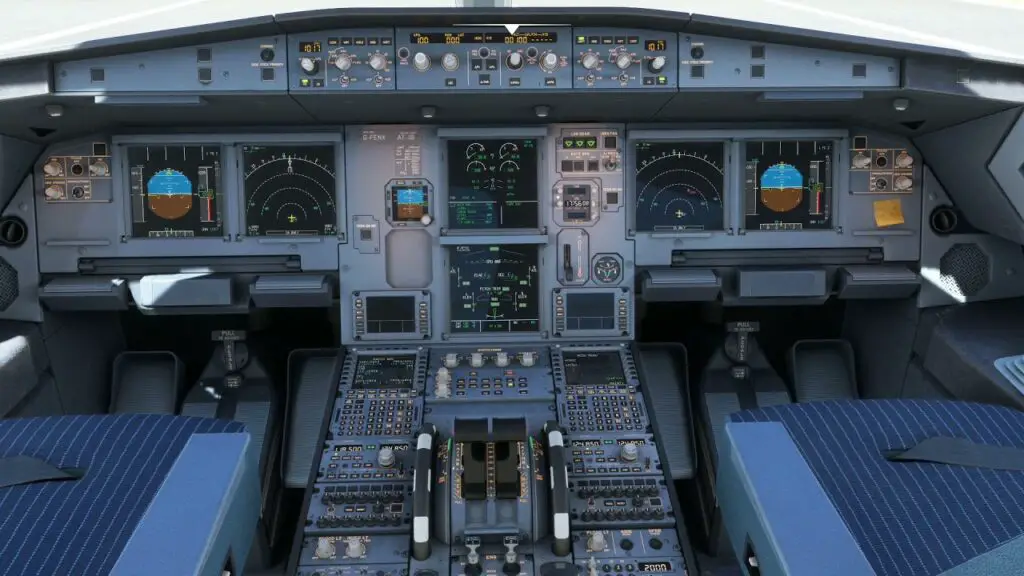Recently, the Fenix A320 and the FlyByWire A320 have been huge hits. People are trying to choose between these simulators and getting more confused as time’s going on.
So, what is the better choice between fenix a320 vs flybywire?
Between Fenix A320 and FlyByWire, Fenix A320 is more realistic and can render better. But, the performance of the FlyByWire is better. FlyByWire is free where as Fenix A320 will cost you around $62. Also, FlyByWire has the new NEO and the Fenix A320 has the old CEO model. But Fenix A320 has more accurate LNAV and VNAV whereas, FlyByWire doesn’t.
You will need more information to choose the optimal simulator for your needs. Read till the end to make the best choice.
Fenix A320 Vs Flybywire: a Brief Comparison
Before providing you with all the in-depth details of these 2 simulators, you need a quick review. The chart below mentions all the key differences between the Fenix A320 and FlyByWire A320. Take a look.
| Differentiating Factors | Fenix A320 | Flybywire A320 |
| Model generation | CEO | NEO |
| LNAV accuracy | Better | Worse |
| VNAV availability | Available fully and completely | Available only on experimental version |
| Performance | Good | Better |
| Simulator | ProSimA320 | Microsoft Flight Simulator |
| Maximum FPS | 34 – 42 | 47 – 52 |
| Beginner friendly | Yes | Yes |
| Rendering | Better | Good |
| Preferred User | Experienced Users | Newbies |
| Fidelity | Higher | Lower |
| Cost | $62 | Free |
By now, you should be ready and intrigued for more information. I’ve broken down the differentiating factors and provided critical information to help you make a decision. Start reading to find out!
Fenix A320 Vs Flybywire: an Elaborated Comparison
Let’s dive deep into the elaborated comparison between these two simulators. This comparison will help you immensely!
Model Generation:
A simulator has limited models of aircraft and the generation is also set beforehand. That’s why it’s important to know the model generation a simulator offers. It’ll also help you in defining the flight model in case of add-ons.
For the Fenix A320, the generation of the A320 is old. It has a CEO (current engine option) engine and a relatively old model. All the cockpits and rendering are also according to that specific model of A320.

On the contrary, the FlyByWire A320 is equipped with a NEO (new engine option) engine. It’s a newer generation aircraft. The generation of the FBW A320 is updated and it also has a modern touch to it.
Summary: In terms of model generation, the FlyByWire A320 has a newer and modern model.
LNAV and VNAV Accuracy:
The LNAV accuracy of the Fenix A320 are impressive. It’s arguably better than the LNAV accuracy of the FlyByWire A320. In FlyByWire, the LNAV is still being implemented and is in the experimental stage.
VNAV is available on Fenix A320 fully and completely. Fenix’s computer uses wind data to calculate VNAV. The VNAV function is fully available and accurate in the simulator. On the contrary, the FlyByWire A320 has VNAV but only in the experimental version.
The VNAV of FlyByWire is improving day by day. Yet, it still can’t beat the VNAV accuracy of the Fenix A320, as of now.
Summary: The LNAV and VNAV accuracy of Fenix A320 easily beats the FlyByWire A320.
Performance and FPS:
FlyByWire A320 offer more performance compared to the Fenix A320. When it comes to fenix a320 vs flybywire fps, FlyByWire offers more FPS.
These tests are done under the GeForce GTX 1660. If you’ve got a better GPU, you will surely get more FPS! But getting a low-level GPU might create problems like low FPS, flickering of the Gsync monitor, etc. To get more FPS, you can follow this guide-
Under optimal conditions, the Fenix A320 provides an average of 42 FPS. Inside the cockpit, you will get 34 – 35 FPS. These are the stationary FPS counts for the Fenix A320. While flying, you can get around 35 FPS with the Fenix A320.
On the contrary, the FlyByWire A320 will deliver a steady 47 FPS when stationary. Also, inside the cockpit, it can push out around 38 FPS. While airborne, FlyByWire A320 can deliver around 52 FPS, which is a big boost compared to the Fenix A320.
Note that, the smoothness and FPS don’t co-relate. The smoothness of the simulator solely depends on the refresh rate of your monitor. You can try getting a 144Hz monitor for a more buttery smooth gameplay experience.
Summary: With the FlyByWire A320 simulator, you’ll get around 10-15% more FPS than the Fenix A320!
Rendering and Fidelity:
The attention to detail matter immensely when it comes to simulators. The better the simulator is at rendering, the more realistic it is! The Fenix A320 has a fully rendered cabin, a more detailed MCDU, etc.
The systems of Fenix are more realistic and provide a more authentic experience in comparison to FlyByWire. The Fenix A320 uses ProSim320. This explains the richness and realism of the detail.
Even the flight planning tools of the Fenix A320 give you more options and information. Moreover, the sound pack of the Fenix A320 adds to the fidelity and makes it more realistic. The sounds of the engines, flaps, gear movements, etc are on point.

The FlyByWire A320 simulator has good amounts of rendering but is not as good as the Fenix A320.
The MCDU has less detail and the overall material texture is low on the FlyByWire A320. The FlyByWire A320 uses the Microsoft Flight Simulator to extract the details.
The biggest downside of this simulator is it doesn’t have a fully rendered cabin. You cannot walk around the cabin, which is a bummer for most people.
FlyByWire’s EFB system is more expressive and detailed when compared to the Fenix A320. Although it depends on the flight simulation network you choose. For instance, the differences between ivao and vatsim networks may affect the latency and details.
Summary: Between the FlyByWire A320 and Fenix A320, Fenix A320’s the more realistic one as it has high fidelity!
Preferred User:
Different simulator users have different preferences. The same goes with the FlyByWire A320 and Fenix A320.
Users who are relatively new and getting into the whole flight simulator activities, go with the FlyByWire A320. As this simulator gives an excellent overall experience of a flight.
On the contrary, more experienced users and people who dig the authentic flight experience go with Fenix A320. It provides a more detailed preview and experience of real-life flight!
Summary: People with experience go with Fenix A320 and new and intrigued users prefer FlyByWire A320.
Cost:
Pricing is one of the most important factors when you have to decide if you want to buy something or not.
The Fenix A320 is priced at 62$. You can buy this simulator from their official store. For what it offers, a lot of users have claimed it to be worth it. The reviews of this simulator are good as well.
However, the FlyByWire A320 is completely free. Yes, you might be in disbelief but you can download the FBW A320 simulator free of cost. As freeware, the FlyByWire A320 is a tremendous package and nothing can beat it in terms of cost!
Summary: In this section, FlyByWire A320 easily beats Fenix A320 because it’s completely free.
Fenix A320 Vs Flybywire: Which Simulator Should You Pick?
The time has come to make up your mind about these 2 simulators. Below, I’ve provided a briefing of these 2 simulators to further simplify your choices.
If you’re looking for a top of line details and high-fidelity pick Fenix A320. You can also get accurate VNAV and LNAV in your favor. Furthermore, the Fenix A320 is recommended if you’re a professional.
Still, you’ll be getting an old-generation aircraft with a little less performance compared to the FlyByWire A320. Moreover, you have to pay 62$ for this simulator!
On the contrary, choose FlyByWire A320 if you want a new generation model aircraft. You can also get a performance and FPS boost and you can get this simulator for free! If you are a newbie or a beginner, pick FlyByWire A320.
However, the LNAV/VNAV will be inaccurate and the fidelity will be really low than the Fenix A320.
Frequently Asked Questions (FAQs):
What is the most realistic Flight Simulator?
The most realistic Flight Simulator is the X-Plane 12. For the past decade, this has been the most realistic flight simulator of aviation. Detailed cockpits, realistic scenery and aerodynamic modeling, functional environment, etc are taken into account here.
Can beginners use a flight simulator?
Yes, beginners can use a flight simulator but it may be difficult. It takes time to know all the aviation codewords, phraseologies, rules, ATC terminologies, etc. Without the proper knowledge, using a flight simulator will always be challenging. So although new players will face difficulty, they can overcome it with time.
How long does a runway need to be for an A320?
For an A320, the runway needs to be at least 6 thousand feet. The smaller brother of the A320, the A318 needs around 5,850 feet of runway. Since the A320 is a bit bigger in size, there’s an increment in the runway segment.
Conclusion
The above discussion should help you clearly see the differences between fenix a320 vs flybywire. Hopefully, it has simplified your decision-making process!
Both of the simulators rely heavily on the peripherals of your PC. Always make sure you have the minimum requirements; if not better. It’ll help deliver the best simulator experience.
Best of luck!
